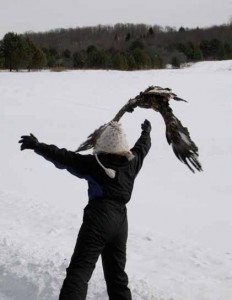The town of Franklin is blessed in many ways but over the past three years, it has been discovered that we are home to a truly remarkable winter resident – the Golden Eagle. And not just passing through. The eagles actually spend a few months here. This research has been documented by members of the Delaware Otsego Audubon Society, whose sanctuary on Franklin Mountain hosts Hawkwatch, one of the most important sites for observing and tracking migrating birds, most notably raptors, along the east coast of North America.

Located on the north-facing slope of Franklin Mountain, Hawkwatch provides an enormous view of the Susquehanna River Valley. Birdwatchers can watch the approach of the migrating birds flying down from the north from miles and miles away. On any day during fall migrating season, there will be a group of dedicated volunteeers scanning the sky with binoculars and trading bird stories. A bird count is kept here throughout the fall migration. I have frequently gone up there with my grandson after school and occasionally there have been so many birds that I’ve been unable to keep up with the count. Hawkwatch is also a location for many activities year round, such as birding walks and lectures, a day camp for children in the summer and a raptor banding station.
Over the past few years, documenting the previously unknown presence of winter resident Golden Eagles has become the most exciting activity of the group. The Delaware-Otsego Audubon Society has been organizing baited sites using wildlife cameras – motion activated, weather proof cameras – starting with six sites in 2011 and increasing to ten sites this past winter, 2014. The sites, conducted under License to Collect and Possess #1386, are set up after the close of deer hunting season and most continue operating into March. Eight of the 2014 baited sites were in Otsego County and two were in Delaware, located on high ridges, preferably wooded, with small openings in the forest cover. Posted private land is preferred so that hunters or trappers will not disturb birds attracted to the camera traps. Road-killed deer carcasses are used as bait. All carcasses are checked for the presence of bullet wounds before being placed. Those with bullet wounds are rejected completely or in part because the use of lead bullets has proven lethal to scavenging birds such as eagles.
In 2014, seventeen winter resident Golden Eagles were photographed at eight sites and three Golden Eagles were captured and telemetered. Radio telemetry is now universally used to chart bird movements, in small local breeding territories as well as the huge path patterns of international migratory species. Besides species conservation uses, radio telemetry has important applications in the investigation of infectious diseases of migratory species. The capture, handling and marking of wild birds are activities strictly regulated in most countries. The radio instruments used are small and very lightweight and amazingly accurate over large areas and extended time periods. The birds are captured briefly with rocket nets and the telemeters are quickly attached to the center of their backs between the wings where they will not impede movement. Undisturbed, they can continue sending data for months, even years.
Studies of bird movements are vitally important for learning the interactions between their migration paths and the development of renewable energy, especially wind power. The mid-Atlantic region is becoming attractive for wind power development but it is also has the primary responsibility for the conservation of the eastern population of North America’s Golden Eagles. This population is small, geographically separate, and potentially genetically distinct from western populations. Breeding in northeastern Canada and wintering in the southern Appalachians, the entire Golden Eagle population passes through our region twice each year. Movement of these birds does not vary – migrating Golden Eagles concentrate in a narrow thirty to fifty mile wide corridor. The survival of these rare birds depends on responsible management of the habitat they use and it is essential to research and identify ways to mitigate prospective impacts on this and similar raptor species. Visit Hawkwatch this fall and perhaps you will see one.
The Delaware Otsego Audubon Society Sanctuary is located at 52 Grange Hall Rd which runs from the Town of Franklin into the Town of Oneonta.
For detailed directions to the Hawkwatch as well as to learn about their projects and events, see their website doas.us
